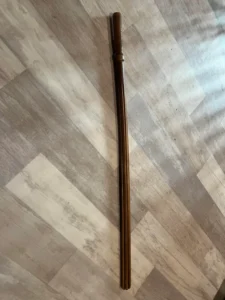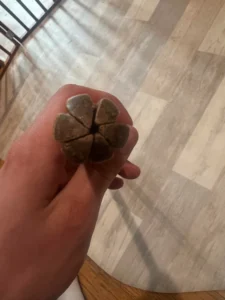A questioner said:
It looks pretty old, the base is definitely a handle, and it was tied together with a rubber band for storeage. None of us have any idea what it could be?



Some of the people opinions on it were:
**Theazel**: “It’s for newspapers! It allows you to use the stick as a ‘spine’ as you would a book: slide the pages into the slots and Bob’s your uncle! Libraries use them often.”
**Odiffido**: “Omg, that makes so much sense! Thank you!”
**RogueAOV**: “Honestly thought it was an executive switch, glad it is more respectable lol.”
**they_are_out_there**: “A lot of public libraries still use these in their newspaper and magazine sections.”
**BaconAlmighty**: “This is it, we used to have a rack of them at the libraries too.”
**dvsdaff**: “I thought it was some type of whip.”
**MarkovChains**: “It looks like something you would use to smack kids with.”
**Jammin_neB13**: “Reminds me of a kendo stick from WWE hardcore matches lol.”
**drax11699**: “Looks like a Kendo stick without the wrapping holding it together.”
**Azzhole169**: “Used to have racks of these in doctor’s offices and at the libraries. Newspaper holders.”
**TrickAssly**: “Definitely for newspapers, but you can also beat some ass with it.”
**karatemikepatolino**: “I think the police in India use those and they help to fight off snakes.”
**Lunchbox9000**: “My grandma used one of these for whisking large amounts of ingredients. Like when it was perogy-making weekend, you would beat the potatoes in a 5-gallon pail with that stick and water. It would peel them. Here’s a new one.”
What do you think? Let us know in the comment!
—————————————–
It looks pretty old. The base is definitely a handle, and it was tied together with a rubber band for storage. None of us have any idea what it could be. This enigmatic object has piqued our curiosity and sparked a lively debate about its origins and purpose. Upon first glance, the object exudes an air of antiquity. The handle, worn smooth by countless hands, suggests it has seen many years of use. The rubber band securing it for storage hints at a pragmatic solution to keep its components together, but it does little to reveal the object’s true function. The handle is the most distinctive feature. Made of wood, metal, or perhaps a combination of materials, it is ergonomically shaped, indicating that it was designed for frequent handling. The craftsmanship suggests a time when tools were made with care and precision, hinting at a period when everyday items were not disposable but built to last. With no definitive answer at hand, we are left to speculate about the object’s purpose. Here are a few theories that have emerged from our collective brainstorming sessions:
1. **A Vintage Kitchen Tool**: One popular theory is that it could be an old kitchen implement. Perhaps it was used for grinding, mixing, or pressing ingredients. The handle’s ergonomic design supports the idea that it was meant for repetitive tasks, possibly making it a pestle, butter churn handle, or a hand mixer.
2. **A Gardening Tool**: Another possibility is that it is a gardening tool. The sturdy handle could have been attached to a variety of heads for digging, planting, or weeding. This would explain the wear and tear, as gardening tools often endure harsh conditions.
3. **A Sewing or Crafting Aid**: Some have speculated that it might be related to sewing or crafting. It could be part of an antique loom, spinning wheel, or quilting frame, where the handle played a crucial role in guiding or tensioning materials.
4. **A Musical Instrument Component**: Considering its age and craftsmanship, it might be a piece of a musical instrument. The handle could belong to a hand-cranked phonograph, an organ pump, or even a bellows for an old wind instrument.
5. **A Mystery from the Workshop**: There’s also a chance that it could be a tool from a workshop or factory. The handle might have been part of a larger mechanism used for shaping, cutting, or assembling materials.
To uncover the true identity of this mysterious object, several steps can be taken:
1. **Research and Expert Opinions**: Consulting with historians, antique dealers, or experts in specific fields like culinary arts, gardening, or music might shed light on its origins.
2. **Reference Materials**: Searching through old catalogs, manuals, and books on tools and household items from various periods can provide visual comparisons and descriptions that match our object.
3. **Community Inquiries**: Posting images and descriptions in online forums or social media groups dedicated to antiques and historical items can attract input from a wide audience, increasing the chances of identifying it.
4. **Museums and Collections**: Visiting museums or collections that focus on everyday historical objects might reveal similar items on display, providing context and identification.
While the exact purpose of this old, rubber-banded handle remains elusive, the journey to discover its identity is enriching. It connects us to the past, prompting us to consider how previous generations lived, worked, and created. Each theory and speculation invites us to use our imagination and appreciate the craftsmanship and utility of bygone eras.
In the end, whether we uncover its true purpose or not, this mysterious object serves as a tangible link to history. It reminds us that every tool, no matter how obscure, once played a vital role in someone’s daily life. As we continue to explore and speculate, we are not just solving a puzzle but also honoring the ingenuity and resourcefulness of those who came before us.





